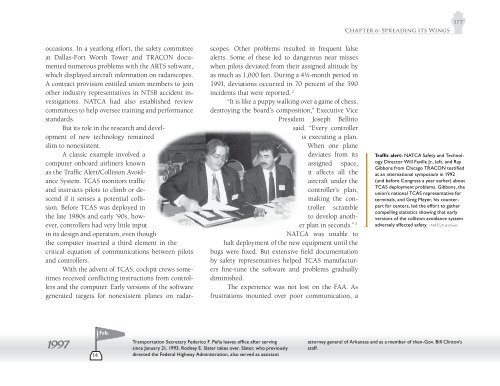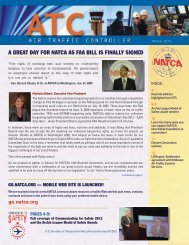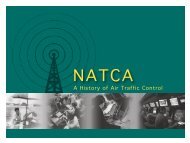Against the Wind - National Air Traffic Controllers Association
Against the Wind - National Air Traffic Controllers Association
Against the Wind - National Air Traffic Controllers Association
You also want an ePaper? Increase the reach of your titles
YUMPU automatically turns print PDFs into web optimized ePapers that Google loves.
occasions. In a yearlong effort, <strong>the</strong> safety committee<br />
at Dallas-Fort Worth Tower and TRACON documented<br />
numerous problems with <strong>the</strong> ARTS software,<br />
which displayed aircraft information on radarscopes.<br />
A contract provision entitled union members to join<br />
o<strong>the</strong>r industry representatives in NTSB accident investigations.<br />
NATCA had also established review<br />
committees to help oversee training and performance<br />
standards.<br />
But its role in <strong>the</strong> research and development<br />
of new technology remained<br />
slim to nonexistent.<br />
A classic example involved a<br />
computer onboard airliners known<br />
as <strong>the</strong> <strong>Traffic</strong> Alert/Collision Avoidance<br />
System. TCAS monitors traffic<br />
and instructs pilots to climb or descend<br />
if it senses a potential collision.<br />
Before TCAS was deployed in<br />
<strong>the</strong> late 1980s and early ’90s, however,<br />
controllers had very little input<br />
in its design and operation, even though<br />
<strong>the</strong> computer inserted a third element in <strong>the</strong><br />
critical equation of communications between pilots<br />
and controllers.<br />
With <strong>the</strong> advent of TCAS, cockpit crews sometimes<br />
received conflicting instructions from controllers<br />
and <strong>the</strong> computer. Early versions of <strong>the</strong> software<br />
generated targets for nonexistent planes on radar-<br />
1997<br />
14<br />
Feb.<br />
scopes. O<strong>the</strong>r problems resulted in frequent false<br />
alerts. Some of <strong>the</strong>se led to dangerous near misses<br />
when pilots deviated from <strong>the</strong>ir assigned altitude by<br />
as much as 1,000 feet. During a 4½-month period in<br />
1991, deviations occurred in 70 percent of <strong>the</strong> 590<br />
incidents that were reported. 2<br />
“It is like a puppy walking over a game of chess,<br />
destroying <strong>the</strong> board’s composition,” Executive Vice<br />
President Joseph Bellino<br />
said. “Every controller<br />
is executing a plan.<br />
When one plane<br />
deviates from its<br />
assigned space,<br />
it affects all <strong>the</strong><br />
aircraft under <strong>the</strong><br />
controller’s plan,<br />
making <strong>the</strong> controller<br />
scramble<br />
to develop ano<strong>the</strong>r<br />
plan in seconds.” 3<br />
NATCA was unable to<br />
halt deployment of <strong>the</strong> new equipment until <strong>the</strong><br />
bugs were fixed. But extensive field documentation<br />
by safety representatives helped TCAS manufacturers<br />
fine-tune <strong>the</strong> software and problems gradually<br />
diminished.<br />
The experience was not lost on <strong>the</strong> FAA. As<br />
frustrations mounted over poor communication, a<br />
Transportation Secretary Federico F. Peña leaves office after serving<br />
since January 21, 1993. Rodney E. Slater takes over. Slater, who previously<br />
directed <strong>the</strong> Federal Highway Administration, also served as assistant<br />
Chapter 6: Spreading its Wings<br />
177<br />
<strong>Traffic</strong> alert: NATCA Safety and Technology<br />
Director Will Faville Jr., left, and Ray<br />
Gibbons from Chicago TRACON testified<br />
at an international symposium in 1992<br />
(and before Congress a year earlier) about<br />
TCAS deployment problems. Gibbons, <strong>the</strong><br />
union’s national TCAS representative for<br />
terminals, and Greg Meyer, his counterpart<br />
for centers, led <strong>the</strong> effort to ga<strong>the</strong>r<br />
compelling statistics showing that early<br />
versions of <strong>the</strong> collision avoidance system<br />
adversely affected safety. / NATCA archives<br />
attorney general of Arkansas and as a member of <strong>the</strong>n-Gov. Bill Clinton’s<br />
staff.




